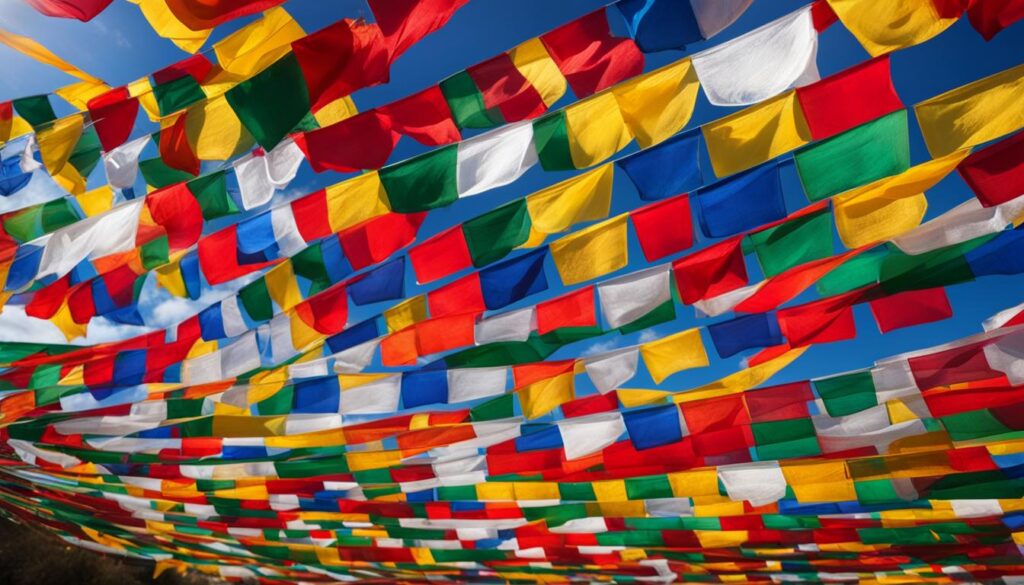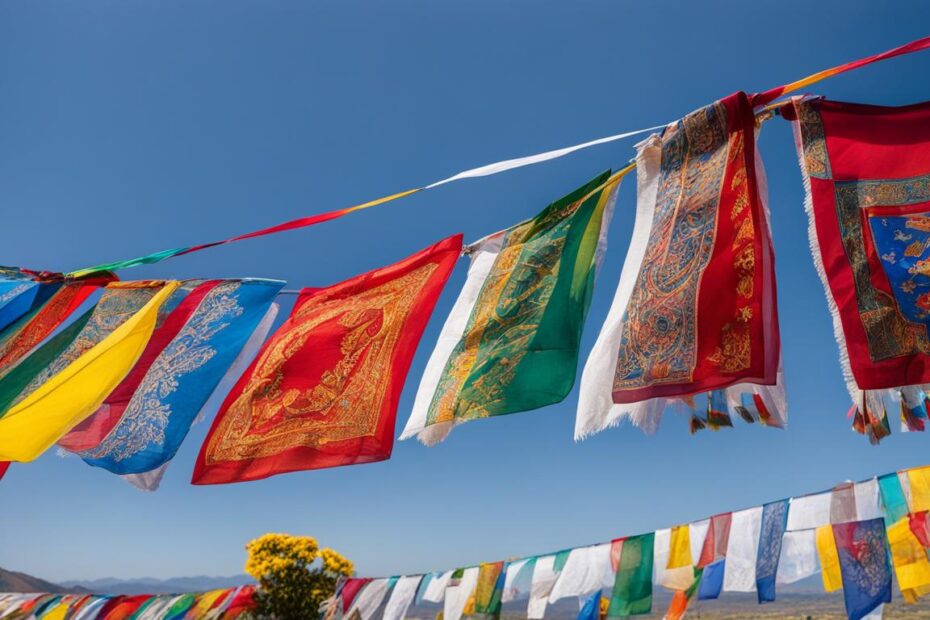Prayer flags are an integral part of Tibetan and Buddhist traditions, steeped in history and imbued with spiritual significance. These sacred tools are used to spread positive energy and goodwill among all beings. Join us as we delve into the world of prayer flags, exploring their main tools, usage, symbolism, sect variations, materials, and evolution over time.
Key Takeaways:
- Prayer flags are essential tools in Tibetan and Buddhist traditions, symbolizing peace and compassion.
- They are used to spread positive energy and goodwill among all living beings.
- The five colors of prayer flags (blue, white, red, green, and yellow) represent elements and signify balance in life and spirituality.
- There are variations in design and usage among different sects.
- Prayer flags are typically made of cotton, printed with sacred mantras and symbols, and they have evolved in style and materials over time.
Steeped in Buddhist Tradition: The Origins of Prayer Flags
Buddhist prayer flags have a rich history rooted in ancient Buddhist tradition. According to legend, prayer flags were first used by Gautama Buddha himself. The flags were carried into battle by devas, celestial beings, as a means to spread the teachings of Buddha and promote goodwill.
These flags have since become an integral part of Tibetan and Buddhist culture, symbolizing peace, compassion, and the interconnectedness of all living beings. They are believed to bring harmony and blessings wherever they are flown.
The use of prayer flags has spread beyond the borders of Tibet and Buddhism. Today, people from different cultures and backgrounds appreciate the beauty and symbolism of these colorful banners. Whether hung in a mountain pass or displayed in a garden, prayer flags serve as a powerful reminder of our shared humanity and the importance of compassion in our lives.
Prayer Flags: An Ever-Evolving Tradition
Over time, prayer flags have undergone changes in design and materials used. Originally, flags were made from animal bones and wooden blocks, with prayers and mantras carved into their surfaces. Today, prayer flags are typically made from fabric, often silk or cotton, with prayers and sacred symbols printed or embroidered onto them.
While the basic format of prayer flags, with their rectangular shape and vertical arrangement, remains consistent, there are variations in design and usage among different Buddhist sects. Some flags may feature specific symbols or mantras associated with a particular sect or lineage.
The Power of Prayer Flags
“Just as the wind carries the scent of flowers, prayer flags carry the vibration of prayers and mantras, spreading positive energy and blessings to all.” – Tibetan proverb
The vibrant colors of Tibetan prayer flags, such as blue, white, red, green, and yellow, hold significant symbolism. Each color represents an element and carries its own meaning. For example, blue symbolizes sky and space, while white represents air, red symbolizes fire, green represents water, and yellow signifies earth. Together, these colors represent balance and harmony.
As prayer flags flutter in the wind, they release the prayers and mantras inscribed upon them, spreading positive energy to all beings. The wind is believed to carry these blessings far and wide, bringing peace, compassion, and well-being to the world.
| Type of Prayer Flag | Description |
|---|---|
| Horizontal Flags | The most common type of prayer flag, these rectangular flags are strung horizontally between two points. They are often seen along mountain ridges, high passes, and other scenic locations. |
| Vertical Flags | Vertical prayer flags, also known as “dar-ding,” are mounted on poles and are commonly found at monasteries and religious sites. |
| Table Flags | Table flags are smaller-sized flags that can be placed on altars, shrines, or personal meditation spaces. |
The Meaning Behind the Colors of Prayer Flags
Tibetan prayer flags are renowned for their vibrant colors, each of which holds symbolic significance. The five colors – blue, white, red, green, and yellow – represent different elements and aspects of life. Let’s explore the deeper meanings behind these colors:
- Blue: Symbolizes the sky and space, representing wisdom, purity, and vastness.
- White: Symbolizes air and clouds, signifying purity, peace, and knowledge.
- Red: Symbolizes fire, symbolizing power, strength, and transformation.
- Green: Symbolizes water, representing harmony, balance, and healing.
- Yellow: Symbolizes earth, signifying balance, grounding, and compassion.
Together, these colors create a harmonious balance, encompassing the interconnectedness of the elements and the spiritual aspects of life. The symbolism of the colors resonates deeply within Tibetan and Buddhist traditions, reflecting the pursuit of spiritual growth and enlightenment.
The Symbolism of Prayer Flag Colors
The colors on prayer flags are not merely decorative; they serve as a visual representation of a profound spiritual philosophy. Each color is believed to have an impact on the environment and the individual, promoting positive energy and well-being.
“The vibrant colors of prayer flags symbolize the unity of all things.”
The symbolism of prayer flag colors is often interpreted in different ways among sects and practitioners. While some variations exist, the core symbolism remains consistent, emphasizing the interconnectedness and interdependence of all beings.
| Color | Symbolic Meaning |
|---|---|
| Blue | Wisdom, purity, and vastness |
| White | Purity, peace, and knowledge |
| Red | Power, strength, and transformation |
| Green | Harmony, balance, and healing |
| Yellow | Balance, grounding, and compassion |
These symbolic meanings are deeply ingrained in the Tibetan and Buddhist cultures, reminding individuals of the interconnectedness of life and the pursuit of spiritual growth and harmony.

As you can see, the colors of prayer flags hold profound meanings, each representing an important aspect of life and spirituality. Through their vivid presence, prayer flags inspire positive energy, compassion, and a deeper connection with the universe.
Exploring the Different Types of Prayer Flags
Tibetan prayer flags come in various types, each with its own unique design and purpose. The most common type is the square-shaped, horizontally strung flag. These flags are typically made of lightweight cloth and feature vibrant colors and intricate designs. They are often hung outdoors, where they can catch the wind and spread their blessings.
Another type of prayer flag is the vertical flag, which is mounted on a pole. These flags are often placed in gardens, temples, or other sacred spaces. They can also be seen lining the paths of religious sites or marking important locations along trekking routes. Vertical prayer flags are believed to be especially effective in spreading positive energy and protection.
While the basic purpose of all prayer flags remains the same – to promote peace, compassion, and well-being – different sects within Tibetan Buddhism may have slight variations in their designs and usage. For example, some flags may have specific mantras or prayers written on them that are associated with a particular sect or deity.
Types of Tibetan Prayer Flags:
| Type | Description |
|---|---|
| Square-shaped flags | The most common type of prayer flag, horizontally strung and hung outdoors. |
| Vertical flags | Mounted on poles and often placed in gardens or sacred spaces. |
| Sect-specific flags | Flags with mantras or prayers associated with a particular sect or deity. |
It’s important to note that prayer flags should be treated with respect and handled carefully. They should be replaced when they become tattered or faded, and they should never be placed on the ground or used for any other purpose than their intended spiritual practice.
The Writing and Symbols on Prayer Flags
Tibetan prayer flags are adorned with sacred mantras, prayers, and symbols that hold deep spiritual significance. These inscriptions and symbols are carefully chosen to evoke positive energy, compassion, and wisdom. The most well-known mantra found on prayer flags is “Om Mani Padme Hum,” which translates to “The jewel in the lotus” and represents compassion and enlightenment.
In addition to mantras, prayer flags also feature various symbols that hold specific meanings in Buddhist philosophy. One such symbol is the Wind Horse, a mythical creature that is believed to carry prayers to the heavens. The Dharma Wheel, representing the teachings of the Buddha, is another common symbol found on prayer flags. Other symbols include the conch shell, symbolizing the call to awaken, and the eight auspicious symbols, representing different aspects of the Buddhist path.
It’s important to note that prayer flags can vary in the specific mantras and symbols used, depending on the sect or lineage of Buddhism. Each sect has its own unique traditions and practices, and these differences are reflected in the design of prayer flags. However, the underlying intention remains the same – to spread positive energy and bring blessings to all beings.
The Usage and Placement of Prayer Flags
Prayer flags are not just decorative pieces, but they serve a specific purpose in spreading blessings and positive energy. The proper hanging and placement of prayer flags are essential to maximize their exposure to the wind and ensure their effectiveness in creating a peaceful and harmonious environment. If you’re wondering how to hang prayer flags and where to place them, here are some guidelines to follow:
- Choose a location with good wind exposure: Prayer flags are designed to flutter in the wind, releasing the prayers and mantras inscribed on them. Therefore, it is crucial to hang them in an area where there is a steady breeze. Mountain passes, high points, and open spaces are ideal locations.
- Avoid placing them on the ground: Prayer flags should never be placed on the ground, as it is considered disrespectful. The flags should always be hung, whether on poles, trees, or buildings.
- Hang them in a high and visible spot: The higher the prayer flags are hung, the better their blessings can reach the surrounding area. Hang them in a spot where they can be easily seen and catch the attention of passersby.
- Respect local customs: If you are in a culturally sensitive area, it’s important to respect the local customs and traditions regarding the placement of prayer flags. Seek guidance from local residents or religious authorities if you are unsure.
By following these guidelines, you can ensure that your prayer flags have the greatest impact and contribute to fostering a sense of peace and well-being in their surroundings.

Table: Dos and Don’ts of Hanging Prayer Flags
| Do | Don’t |
|---|---|
| Choose a location with good wind exposure. | Place prayer flags on the ground. |
| Hang prayer flags in a high and visible spot. | Hang them in a location obstructed by other objects. |
| Respect local customs and traditions. | Hang prayer flags in a disrespectful or inappropriate manner. |
| Ensure the prayer flags are well-maintained. | Hang damaged or worn-out prayer flags. |
Auspicious Days to Hang Prayer Flags
Hanging Tibetan prayer flags on specific auspicious days is believed to enhance the blessings and positive energy generated by these sacred tools. The Tibetan calendar, based on lunar cycles, designates several significant days throughout the year for this purpose. Let’s explore some of the most auspicious days when hanging new prayer flags is considered especially powerful.
Losar: Tibetan New Year
Losar, the Tibetan New Year, is one of the most important and joyful festivals in Tibetan culture. It usually falls in February or March and is celebrated with various rituals and festivities. Hanging new prayer flags during Losar is believed to bring renewed blessings, prosperity, and good fortune for the coming year. It is a time when communities come together to offer prayers, make offerings, and engage in spiritual practices.
Saga Dawa Festival
The Saga Dawa Festival is another auspicious time to hang prayer flags. This month-long festival commemorates the birth, enlightenment, and parinirvana (passing away) of Gautama Buddha. It usually takes place around May or June. During this festival, many Buddhists engage in acts of kindness, generosity, and spiritual practice. Hanging prayer flags during Saga Dawa is believed to multiply the positive effects and spiritual merit.
Dakini Day
Dakini Day, celebrated on the 25th day of each lunar month in the Tibetan calendar, is considered an auspicious time for spiritual activities. Dakinis are female enlightened beings associated with wisdom and compassion. On Dakini Day, devotees engage in practices aimed at cultivating compassion and wisdom. Hanging prayer flags on this day is believed to enhance the potency of prayers and invoke the blessings of the dakinis.
| Auspicious Day | Significance |
|---|---|
| Losar | Tibetan New Year |
| Saga Dawa Festival | Commemorating Buddha’s birth, enlightenment, and parinirvana |
| Dakini Day | Associated with the wisdom and compassion of female enlightened beings |
These are just a few examples of the auspicious days when hanging prayer flags is considered particularly effective. The intention behind the act of hanging prayer flags on these days is to accumulate positive energy, purify negative karma, and create a harmonious environment. However, it’s worth noting that prayer flags can be hung at any time throughout the year, as their purpose is to continuously spread positive energy and blessings.

By aligning the placement of prayer flags with these auspicious days, practitioners aim to amplify the positive impact of these sacred tools. Whether it’s during the vibrant celebration of Losar, the sacred observances of Saga Dawa, or the serene contemplation of Dakini Day, hanging prayer flags on these significant occasions serves as a powerful reminder of the interconnectedness of life and the pursuit of peace and compassion.
Tibetan Prayer Flags as Cultural and Artistic Symbols
Tibetan prayer flags are not only revered for their spiritual significance but also appreciated as cultural and artistic symbols of peace and compassion. These vibrant flags have become popular collectibles for people worldwide, including tourists who wish to bring a piece of Tibetan culture and tradition into their homes.
Prayer flags are often seen as works of art that not only showcase the craftsmanship of the Tibetan artisans but also represent the values and beliefs of Tibetan Buddhism. The intricate designs, vibrant colors, and sacred symbols adorning the flags make them visually captivating and spiritually inspiring.
“Tibetan prayer flags are not just pieces of cloth fluttering in the wind. They are a living tradition that carries the hopes and aspirations of countless individuals seeking peace, harmony, and compassion.”
Many individuals use prayer flags as decorative elements in their homes and gardens. They are often hung in strategic locations where the wind can catch them, allowing the prayer flags to release positive energy and blessings into the environment.
Tibetan prayer flags serve as a reminder of the interconnectedness of all living beings and the importance of fostering peace and compassion in the world. By displaying and appreciating these cultural and artistic symbols, we contribute to the preservation of Tibetan tradition and promote the values of harmony and goodwill.

The Beauty of Prayer Flags
| Type | Symbolism | Materials |
|---|---|---|
| Horizontal Flags | Spread blessings and positive energy | Cotton or polyester fabric |
| Vertical Flags | Auspicious prayers and mantras | Cotton or silk fabric |
| Windhorse Flags | Transformation of bad fortune to good fortune | Cotton or silk fabric |
| Square Flags | Overall well-being and protection | Cotton or silk fabric |
These prayer flags, with their rich symbolism and artistic beauty, continue to capture the imagination and admiration of people around the world. Whether displayed as decorative pieces or used in spiritual practices, Tibetan prayer flags serve as a powerful reminder of the values we should strive for: peace, compassion, and the interconnectedness of all beings.
The Power and Beauty of Windhorse Prayer Flags

Among the various types of prayer flags, Windhorse prayer flags, also known as lungta prayer flags, hold a special place in Tibetan and Buddhist traditions. These prayer flags feature the powerful symbol of a horse surrounded by sacred mantras and auspicious symbols, representing the transformation of bad fortune to good fortune.
Handmade and blessed by Tibetan Buddhist nuns, Windhorse prayer flags are believed to possess immense spiritual power. They are considered a potent tool for promoting peace, compassion, and overall well-being. The image of a horse symbolizes the strength, energy, and vitality to overcome obstacles and achieve success.
When hung in the wind, Windhorse prayer flags release their blessings and spread positive energy throughout the environment. They serve as a reminder to cultivate inner qualities such as kindness, courage, and wisdom. These flags create a visual spectacle, with their vibrant colors and intricate designs, and add a touch of beauty to any space.
The Symbolism of Windhorse Prayer Flags
The Windhorse symbolizes the human aspiration to transcend suffering and attain enlightenment. It represents the union of earth and sky, symbolizing the harmony between the earthly existence and spiritual realms. The horse is depicted running swiftly, carrying the prayers and aspirations of all sentient beings into the boundless expanse of the universe.
“The Windhorse prayer flags remind us of the interconnectedness of all beings and the potential for transformation and growth.”
The sacred mantras and auspicious symbols surrounding the horse on the Windhorse prayer flags empower individuals to cultivate positive qualities within themselves. The mantras are believed to have a purifying effect on the environment, while the symbols evoke qualities such as compassion, wisdom, and protection. These flags are thus an embodiment of the Buddhist teachings and serve as a source of inspiration and guidance for all who encounter them.
| Symbol | Meaning |
|---|---|
| Windhorse (Lungta) | Strength, energy, and vitality |
| Mantras | Purification and positive energy |
| Auspicious Symbols | Compassion, wisdom, and protection |
Windhorse prayer flags are not only a cherished spiritual tool but also a beautiful artistic expression of Tibetan culture. They encapsulate the profound teachings of Buddhism and serve as a visual reminder of our interconnectedness with all beings. The power and beauty of Windhorse prayer flags continue to captivate hearts and minds, inviting individuals to embark on a journey of self-discovery and transformation.
Conclusion
Tibetan prayer flags are not just colorful pieces of fabric; they are powerful tools that carry deep spiritual significance. These flags serve as a symbol of peace, compassion, and unity among all living beings. By hanging prayer flags, individuals can connect with an ancient tradition and experience the vibrant power they hold.
Throughout Buddhist history, prayer flags have been used to spread positive energy and goodwill. The main prayer tool, the prayer flag, is traditionally hung in specific locations to maximize its exposure to the wind, allowing its blessings and positive energy to be carried far and wide.
Each color on the prayer flag holds symbolic meaning, representing different elements and aspects of spirituality. The sacred mantras and symbols inscribed on the flags, such as the Wind Horse and the Dharma Wheel, further enhance their spiritual significance.
While there may be variations in design and usage among different sects, the purpose of prayer flags remains the same – to promote harmony, compassion, and overall well-being. Prayer flags can be found not only in religious sites but also in homes and gardens, where they serve as decorative elements and reminders of our interconnectedness.
FAQ
What are prayer flags?
Prayer flags are an important part of Tibetan and Buddhist traditions. They are colorful flags that are used to spread positive energy and goodwill.
What is the significance of prayer flags?
Prayer flags serve as a medium for spreading positivity, compassion, and peace. They are believed to bring blessings and promote overall well-being.
What do the colors on prayer flags represent?
The five colors on Tibetan prayer flags – blue, white, red, green, and yellow – symbolize elements like the sky, air, fire, water, and earth. Together, they represent balance and different aspects of spirituality and life.
What are the different types of prayer flags?
The most common types of Tibetan prayer flags are square-shaped, horizontally strung flags. There are also vertical flags mounted on poles. Each type serves the purpose of spreading positivity and compassion, with slight variations in design and usage.
What is written on prayer flags?
Tibetan prayer flags are inscribed with sacred mantras, prayers, and symbols that hold deep spiritual significance. The most famous mantra is “Om Mani Padme Hum,” which is associated with compassion and wisdom. Prayer flags also feature symbols like the Wind Horse, the Dharma Wheel, the conch shell, and the eight auspicious symbols of Buddhism.
Where should prayer flags be hung?
Prayer flags are traditionally hung in specific locations to maximize their exposure to the wind. They are often hung at mountain passes, bridges, river banks, along trekking routes, and at religious sites. They can also be displayed in homes and gardens.
Are there auspicious days for hanging prayer flags?
Yes, certain days like Losar (Tibetan New Year) and Saga Dawa Festival (commemorating Buddha’s birth, enlightenment, and parinirvana) are considered auspicious for hanging new prayer flags. These days are believed to enhance the blessings and positive energy created by the flags.
Are prayer flags exclusive to Tibetan Buddhism?
No, prayer flags are appreciated for their cultural and artistic symbolism of peace and compassion. Many people, including tourists, collect prayer flags as souvenirs. Respectful handling and appropriate placement to catch the wind are important aspects of owning prayer flags.
What are Windhorse prayer flags?
Windhorse prayer flags are the most popular type of prayer flags. They feature the powerful symbol of a horse surrounded by mantras and auspicious symbols. Windhorse prayer flags are handmade and blessed by Tibetan Buddhist nuns. They represent the transformation of bad fortune to good fortune and promote peace, compassion, and overall well-being.
What is the significance of prayer flags in Tibetan and Buddhist traditions?
Tibetan prayer flags hold a deep spiritual significance. They serve as a symbol of peace, compassion, and unity among all living beings. The vibrant colors, symbolism, and proper placement of prayer flags remind us of the interconnectedness of life and the pursuit of harmony and goodwill.








